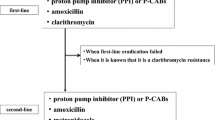Abstract
Background
Helicobacter pylori is the most important cause of gastritis and related morbidities. Following consumption, radioactive iodine accumulates considerably in the stomach. On the basis of this observation, we decided to determine whether the high radiation induced by radio-iodine in the stomach is effective in the eradication of this infection.
Methods
All consecutive patients with differentiated thyroid carcinoma, who were referred for radio-iodine therapy [dose 117.1 ± 24.4 mCi (4.3 ± 0.9 GBq), range 100–200 mCi (3.7–7.4 GBq)], were enrolled. To detect H. pylori infection, the urease breath test (UBT) was performed 1-2 h before radio-iodine consumption and the test was repeated 2 months later.
Results
Of 88 patients, 71 had pre-treatment positive UBT. Of these, 23 patients had negative post-treatment result, which means a significant reduction (26.1%, 95% CI 16.8–35.5%) in the number of positive UBT results in our treated population (32.4% of UBT-positive cases became UBT-negative).
Conclusions
Considering the high prevalence of reinfection in developing countries, the therapeutic benefit would have been more considerable if the second UBT had been done with a lag time of less than 2 months. Although radio-iodine therapy is not a logical method for the treatment of patients suffering from H. pylori, our finding provides indirect evidence about the radiosensitivity of bacteria, the future clinical applications of which need to be further evaluated. Also this finding can be useful for the food industry, where radiation is used widely to sterilize food. Regarding the possibility of H. pylori suppression, we recommend not using UBT for screening for the infection for at least within 2 months following radio-iodine therapy.
Similar content being viewed by others
References
Suerbaum S, Michetti P. Helicobacter pylori infection. N Engl J Med 2002;347:1175.
Mitchell HM. The epidemiology of Helicobacter pylori. Curr Top Microbiol Immunol 1999;241:11.
Walker MM, Crabtree JE. Helicobacter pylori infection and the pathogenesis of duodenal ulceration. Ann N Y Acad Sci 1998;859:96.
Blaser MJ. Hypothesis: the changing relationships of Helicobacter pylori and humans: implications for health and disease. J Infect Dis 1999;179:1523.
Gholamrezanezhad A, Moinian D, Eftekhari M, Mirpour S, Hajimohammadi H. The prevalence and significance of increased gastric wall radiotracer uptake in sestamibi myocardial perfusion SPECT. Int J Cardiovasc Imaging 2006;22: 435–441.
Sweeney DC, Johnston GS. Radioiodine therapy for thyroid cancer. Endocrinol Metab Clin North Am 1995;24:803–839.
Spitzweg C, Joba W, Eisenmenger W, Heufelder AE. Analysis of human sodium iodide symporter gene expression in extrathyroidal tissues and cloning of its complimentary deoxyribonucleic acids from salivary gland, mammary gland and gastric mucosa. J Clin Endocrinol Metab 1998;83:1746–1751.
Shapiro B, Rufini V, Jarwan A, Geatti O, Kearfott KJ, Fig LM, et al. Artifacts, anatomical and physiological variants, and unrelated diseases that might cause false-positive whole-body 131-I scans in patients with thyroid cancer. Semin Nucl Med 2000;30:115–132.
Wu SY, Kollin J, Coodley E, Lockyer T, Lyons KP, Moran E, et al. I131 total body scan: localisation of disseminated gastric adenocarcinoma: case report and survey of the literature. J Nucl Med 1984;25:1204–1209.
Berquist TH, Nolan NG, Stephens DM, Carlson HC. Radioisotope scintigraphy in diagnosis of Barrett’s esophagus. Am J Roentgenol 1971;123:401–411.
Nair N, Basu S, Pakhale H. Unusual uptake of radioiodine in the chest in a patient with thyroid carcinoma. Br J Radiol 2004;77:63–67.
Marshall BJ, Surveyor J. Carbon-14 breath test for the diagnosis of Campylobacter pylori associated gastritis. J Nucl Med 1988;29:11–16.
Bazaz RD, Khalaj A, Beiki D, Eftekhari M, Hosein MHA, Khoshayand MR. Microdose 14C urea breath test for the diagnosis of Helicobacter pylori: a survey in Iranian population. Daru 2005;13:6–10.
Edmonds CJ, Smith T. The long-term hazards of the treatment of thyroid cancer with radioiodine. Br J Radiol 1986;59: 45–51.
Lin WY, Shen YY, Wang SJ. Short-term hazards of low-dose radioiodine ablation therapy in postsurgical thyroid cancer patients. Clin Nucl Med 1996;21:780–782.
Holm LE, Hall P, Wiklund K, Lundell G, Berg G, Bjelkengren G, et al. Cancer risk after iodine-131 therapy for hyperthyroidism. J Nat Cancer Inst 1991;83:1072–1077.
Hall P, Berg G, Bjelkengren G, Boice JD Jr, Ericsson UB, Hallquist A, et al. Cancer mortality after iodine-131 therapy for hyperthyroidism. Int J Cancer 1992;50:886–890.
Huysmans DAKC, Buijs WCAM, van de Ven MTP, van den Broek WJM, Kloppenborg PWC, Hermus ARMM, et al. Dosimetry and risk estimates of radioiodine therapy for large, multinodular goiters. J Nucl Med 1996;37:2072–2079.
Johansson L, Leide-Sveggorn S, Mattson S, Nosslin B. Biokinetics of iodide in man: refinements of current ICRP dosimetry models. Cancer Biother Radiopharm 2006;18:445–450.
Brill AB, Stabin M, Bouville A, Ron E. Normal organ radiation dosimetry and associated uncertainties in nuclear medicine, with emphasis on iodine-131. Radiat Res 2006;166: 128–140.
Rollan A, Giancaspero R, Fuster F, Acevedo C, Figueroa C, Hola K, et al. The long-term reinfection rate and the course of duodenal ulcer disease after eradication of Helicobacter pylori in a developing country. Am J Gastroenterol 2000;95: 50–56.
Eisig JN, Zaterka S, Silva FM, Malfertheiner P, Mattar R, Rodriguez TN, et al. Helicobacter pylori recurrence in patients with duodenal ulcer: clinical, endoscopic, histologic, and genotypic aspects: a 10-year Brazilian Series. Helicobacter 2006;11:431
Author information
Authors and Affiliations
Corresponding author
Rights and permissions
About this article
Cite this article
Gholamrezanezhad, A., Mirpour, S., Saghari, M. et al. Radio-iodine therapy and Helicobacter pylori infection. Ann Nucl Med 22, 917–920 (2008). https://doi.org/10.1007/s12149-008-0197-1
Received:
Accepted:
Published:
Issue Date:
DOI: https://doi.org/10.1007/s12149-008-0197-1




